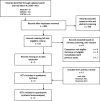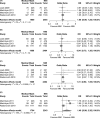Medical masks vs N95 respirators for preventing COVID-19 in healthcare workers: A systematic review and meta-analysis of randomized trials
- PMID: 32246890
- PMCID: PMC7298295
- DOI: 10.1111/irv.12745
Medical masks vs N95 respirators for preventing COVID-19 in healthcare workers: A systematic review and meta-analysis of randomized trials
Abstract
Background: Respiratory protective devices are critical in protecting against infection in healthcare workers at high risk of novel 2019 coronavirus disease (COVID-19); however, recommendations are conflicting and epidemiological data on their relative effectiveness against COVID-19 are limited.
Purpose: To compare medical masks to N95 respirators in preventing laboratory-confirmed viral infection and respiratory illness including coronavirus specifically in healthcare workers.
Data sources: MEDLINE, Embase, and CENTRAL from January 1, 2014, to March 9, 2020. Update of published search conducted from January 1, 1990, to December 9, 2014.
Study selection: Randomized controlled trials (RCTs) comparing the protective effect of medical masks to N95 respirators in healthcare workers.
Data extraction: Reviewer pair independently screened, extracted data, and assessed risk of bias and the certainty of the evidence.
Data synthesis: Four RCTs were meta-analyzed adjusting for clustering. Compared with N95 respirators; the use of medical masks did not increase laboratory-confirmed viral (including coronaviruses) respiratory infection (OR 1.06; 95% CI 0.90-1.25; I2 = 0%; low certainty in the evidence) or clinical respiratory illness (OR 1.49; 95% CI: 0.98-2.28; I2 = 78%; very low certainty in the evidence). Only one trial evaluated coronaviruses separately and found no difference between the two groups (P = .49).
Limitations: Indirectness and imprecision of available evidence.
Conclusions: Low certainty evidence suggests that medical masks and N95 respirators offer similar protection against viral respiratory infection including coronavirus in healthcare workers during non-aerosol-generating care. Preservation of N95 respirators for high-risk, aerosol-generating procedures in this pandemic should be considered when in short supply.
Keywords: COVID-19; N95 respirators; SARS-CoV-2; coronavirus; masks; meta-analysis; systematic review.
© 2020 The Authors. Influenza and Other Respiratory Viruses Published by John Wiley & Sons Ltd.
Figures


Similar articles
-
Physical interventions to interrupt or reduce the spread of respiratory viruses.Cochrane Database Syst Rev. 2020 Nov 20;11(11):CD006207. doi: 10.1002/14651858.CD006207.pub5. Cochrane Database Syst Rev. 2020. Update in: Cochrane Database Syst Rev. 2023 Jan 30;1:CD006207. doi: 10.1002/14651858.CD006207.pub6. PMID: 33215698 Free PMC article. Updated.
-
Physical interventions to interrupt or reduce the spread of respiratory viruses.Cochrane Database Syst Rev. 2023 Jan 30;1(1):CD006207. doi: 10.1002/14651858.CD006207.pub6. Cochrane Database Syst Rev. 2023. PMID: 36715243 Free PMC article. Review.
-
The need of health policy perspective to protect Healthcare Workers during COVID-19 pandemic. A GRADE rapid review on the N95 respirators effectiveness.PLoS One. 2020 Jun 3;15(6):e0234025. doi: 10.1371/journal.pone.0234025. eCollection 2020. PLoS One. 2020. PMID: 32492045 Free PMC article.
-
Comparative effectiveness of N95 respirators and surgical/face masks in preventing airborne infections in the era of SARS-CoV2 pandemic: A meta-analysis of randomized trials.PLoS One. 2020 Dec 15;15(12):e0242901. doi: 10.1371/journal.pone.0242901. eCollection 2020. PLoS One. 2020. PMID: 33320847 Free PMC article.
-
Effectiveness of N95 respirators versus surgical masks in protecting health care workers from acute respiratory infection: a systematic review and meta-analysis.CMAJ. 2016 May 17;188(8):567-574. doi: 10.1503/cmaj.150835. Epub 2016 Mar 7. CMAJ. 2016. PMID: 26952529 Free PMC article. Review.
Cited by
-
Face masks and containment of COVID-19: experience from South Korea.J Hosp Infect. 2020 Sep;106(1):206-207. doi: 10.1016/j.jhin.2020.06.017. Epub 2020 Jun 12. J Hosp Infect. 2020. PMID: 32540463 Free PMC article. No abstract available.
-
Risk of SARS-CoV-2 transmission by aerosols, the rational use of masks, and protection of healthcare workers from COVID-19.Antimicrob Resist Infect Control. 2020 Jul 6;9(1):100. doi: 10.1186/s13756-020-00763-0. Antimicrob Resist Infect Control. 2020. PMID: 32631450 Free PMC article. Review.
-
Improving knowledge, attitudes and practice to prevent COVID-19 transmission in healthcare workers and the public in Thailand.BMC Public Health. 2021 Apr 18;21(1):749. doi: 10.1186/s12889-021-10768-y. BMC Public Health. 2021. PMID: 33865342 Free PMC article.
-
Effects of the COVID-19 Pandemic on Turkish Ophthalmologists.Turk J Ophthalmol. 2021 Apr 29;51(2):95-101. doi: 10.4274/tjo.galenos.2020.52563. Turk J Ophthalmol. 2021. PMID: 33951897 Free PMC article.
-
Coronavirus Disease 2019 (COVID-19): A Literature Review from a Nursing Perspective.Biomedicine (Taipei). 2021 Sep 1;11(3):5-14. doi: 10.37796/2211-8039.1154. eCollection 2021. Biomedicine (Taipei). 2021. PMID: 35223405 Free PMC article. Review.
References
-
- World Health Organization . WHO declares COVID‐19 a pandemic. 2020. https://www.who.int/dg/speeches/detail/who‐director‐general‐s‐opening‐re.... Accessed March 13, 2020.
-
- Centers for Disease Control and Prevention (CDC) . COVID‐19 transmission. 2020. https://www.cdc.gov/coronavirus/2019‐ncov/prepare/transmission.html. Accessed March 15, 2020.
Publication types
MeSH terms
LinkOut - more resources
Full Text Sources
Medical
Miscellaneous

